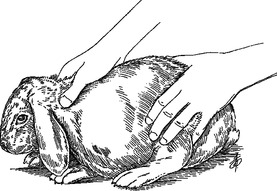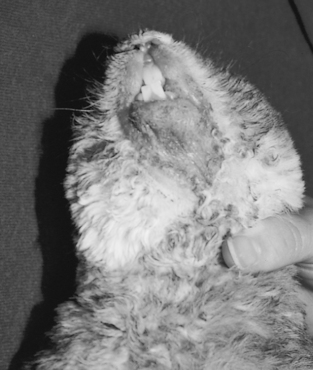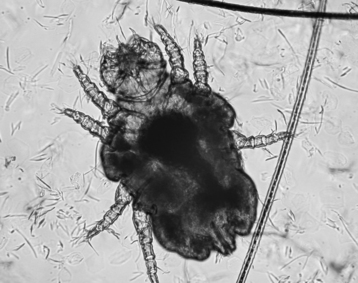CHAPTER 56. Rabbits
Patricia A. Schenck
BIOLOGICAL CHARACTERISTICS
I. Anatomy and Physiology
A. Rabbits are lagamorphs, not rodents. Life span is about 5 to 9 years
B. The dewlap under the chin is prominent in some breeds and is a frequent site of moist dermatitis
C. Teeth grow continuously. Permanent teeth erupt around 3 to 5 weeks of age
D. Rabbits have a simple stomach, a long intestinal tract, and a large cecum. The stomach is rarely empty, and the cecum holds about 40% of the gastrointestinal (GI) contents
E. Cecotrophs are “night feces,” which rabbits normally consume
F. The skeletal system constitutes only about 8% of body weight compared with 13% of body weight in cats
G. Urine may normally be thick and creamy in appearance because of calcium carbonate. Rabbits excrete most of their calcium and phosphorus through the urine. Urine is also periodically red, pink, or orange from porphyrin pigments
H. Neutrophilia and lymphopenia are characteristic of inflammation
II. Reproductive characteristics
A. Females (does) mature at about 4 to 8 months of age, and males (bucks) mature at about 6 to 10 months of age
B. Females are induced ovulators. Mating can occur at any time of the year but is influenced by light and temperature. Gestation is about 30 to 33 days
C. Litters usually range from 4 to 10 kits. Kits are born blind and hairless. Does usually only nurse once daily for 3 to 5 minutes
D. Kits start eating solid food about day 15
MANAGEMENT
I. Caging
A. Cages need to be large enough to allow movement, tall enough to allow the rabbit to stand on its hindlegs, and easy to clean
B. Wire-mesh flooring may be used, but only if it is wide enough and with small enough openings to avoid sore hocks. If wire mesh is used, provide part of the cage with a solid bottom
C. Stray or hay bedding should be provided and cleaned daily. Many rabbits can be trained to use a litterbox because they prefer to urinate and defecate in one spot
D. Rabbits are susceptible to heat stroke at temperatures greater than 85° F. If rabbits are kept outdoors, provide good ventilation, protection from direct sunlight, and protection from flies
E. Rabbits should be allowed time out of the cage for exercise, but only with supervision
II. Diet
A. High-fiber diets are required for GI health and proper wearing of the teeth. Provide free-choice timothy or coastal hay. Alfalfa is high in calcium and should be used with caution
B. A variety of vegetables and fresh, leafy greens should be offered several times daily
C. Pelleted diets may be convenient, but most are alfalfa based, nutrient dense, and low in fiber
D. A small amount of fruits (2 tbsp/2 lb body weight) can be offered daily
E. Fresh water should always be available. Daily average water intake is 50 to 150 mL/kg
CLINICAL TECHNIQUES
I. Restraint
A. Gentle, but firm restraint is important, as inadequate restraint can lead to hindleg kicking with fracture of the spine. Always support the hindquarters when lifting a rabbit (Figure 56-1)
 |
| Figure 56-1 Proper method for restraining a rabbit. (From Birchard SJ, Sherding RG. Saunders Manual of Small Animal Practice, 3rd ed. St Louis, 2006, Saunders.) |
B. Carry a rabbit with its head tucked under one arm with the body resting on the forearm. Use the other hand to stabilize the dorsum of the back and rump
II. Diagnostic techniques
A. Collect blood samples from jugular, cephalic, lateral saphenous, or lateral ear veins. Use a small-gauge needle (25 gauge). To prevent hematomas, apply direct pressure over the site for several minutes. The lateral saphenous vein is the best site for obtaining blood for routine blood tests. Pluck the hair to see the vein more clearly
B. On radiographs, the stomach and cecum are often full of ingesta. Rabbits have small thoracic cavities
C. Ultrasound is useful but requires sedation
III. Treatment techniques
A. Small-gauge catheters (24 gauge) can be placed in the cephalic or lateral saphenous vein. Jugular catheters can be difficult to place. Daily maintenance fluid needs are 100 to 150 mL/kg/day
B. Medications can be given orally into the lateral cheek pouch. Use liquid or paste preparations
C. Anorectic animals can be fed via syringe either a special hand-feeding formula or rabbit pellets that are moistened and made into a gruel. Vegetable baby foods are low in protein and fiber and should be avoided. Nasogastric tubes can be placed
D. Dietary Lactobacillus supplements may be useful in treating enteritis or when treating with antibiotics
IV. Tranquilization, anesthesia
A. Injectable tranquilizers such as ketamine (5 to 10 mg/kg) and medetomidine (0.15 to 0.18 mg/kg) given in combination intramuscularly or intravenously provide relaxation and sedation
B. Inhalant anesthesia
1. Isoflurane or sevoflurane are used for longer procedures. Induction is via face mask or induction chamber. Premedicate with combination of ketamine and metetomidine, especially if using isoflurane. Monitor rabbits closely
2. Intubation can be difficult. Repeated attempts to intubate can damage the larynx; consider using a facemask if intubation is difficult
DERMATOLOGIC PROBLEMS
I. Dermatitis, alopecia
A. Causes
1. Mange, fur, and ear mites
2. Dermatophytosis, especially around head and ears
3. Fur-barbering is common if diet is deficient in roughage
4. Malocclusion can cause alopecia and dermatitis around the mouth (Figure 56-2)
 |
| Figure 56-2 Moist dermatitis under the chin of a rabbit secondary to drooling because of dental malocclusion. (Courtesy Elizabeth Hillyer, DVM.) (From Quesenberry KE, Carpenter JW. Ferrets, Rabbits, and Rodents: Clinical Medicine and Surgery, 2nd ed. St Louis, 2004, Saunders.) |
5. Moist dermatitis of the dewlap is common in warm, humid weather. Moist dermatitis of the ventral abdomen or perineum results from urine scald
6. Treponematosis causes scaly dermatitis in the genital area
B. Clinical signs are dependent on cause. Fur barbering is usually of the dewlap, back of neck, and paws; underlying skin is normal
C. Diagnosis is by examination of skin scrapings, skin biopsy, teeth, radiographs, and serum biochemistry
D. Treatment is aimed at correction of the underlying cause
II. Ear mites
A. Cause is Psoroptes cuniculi, a common parasite. Mites do not burrow but cause inflammation by biting and chewing the epithelial surface of the skin
B. Clinical signs include thick, dry crusts on the inner surface of the ear pinna, with intense pruritus
C. Diagnosis is by examination of the ear canal for mites or by microscopic examination of crusts and exudates
D. Treatment
1. Ivermectin is effective. Clean ears a few weeks after pain subsides. Apply antibiotic cream if there is secondary bacterial infection
2. Mites are easily transmitted. Isolate affected rabbits, and keep cages clean
III. Fur and mange mites
A. Causes: Cheyletiella parasitivorax is the common fur mite and is often called “walking” dandruff. Cheyletid mites are nonburrowing and may cause a transitory dermatitis in humans. Mange mites ( Sarcoptes, Notedres) occur infrequently
B. Clinical signs include a scaly dermatitis with flaky exudates. Mites are primarily on the dorsal trunk and scapular region. Pruritus is not seen with Cheyletiella but is intense with mange mites
C. Diagnosis is by identification of Cheyletiella on cellophane tape preparations of affected skin. Mange mites require deep skin scrapings for identification (Figure 56-3)
 |
| Figure 56-3 Cheyletiella parasitovorax is often described as “walking dandruff.” (From Mitchell MA, Tully TN. Manual of Exotic Pet Practice. St Louis, 2009, Saunders.). |
D. Treatment
1. Ivermectin given subcutaneously (SC) is effective against most mites
2. Treat the environment with parasiticides, and isolate affected rabbits
IV. Myiasis
A. Cause: Fly larval infestation occurs in rabbits housed outdoors in warm weather
B. Clinical signs
1. Cuterebra larvae burrow into tissue causing SC swellings, usually in the ventral cervical, inguinal, hindquarter, dorsum, and axillary regions
2. Maggots burrow through large, moist necrotic areas at the base of the tail and dorsum. Secondary bacterial infections are common
C. Diagnosis is based on the presence of larvae in wounds
D. Treatment
1. Clip hair and remove larvae intact. May require sedation
2. Debride wounds, excise abscessed skin
3. Ivermectin can be used to kill larvae, but larvae will still need to be removed
4. Screen outdoor hutches
V. Superficial mycosis
A. Cause: Usually caused by Trichophyton mentagrophytes or occasionally by Microsporum spp. Transmission is by direct contact, fomites, or asymptomatic carriers. Humans are susceptible
Stay updated, free articles. Join our Telegram channel

Full access? Get Clinical Tree


